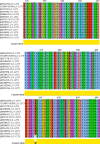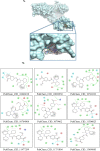Design of novel viral attachment inhibitors of the spike glycoprotein (S) of severe acute respiratory syndrome coronavirus-2 (SARS-CoV-2) through virtual screening and dynamics
- PMID: 32987103
- PMCID: PMC7518233
- DOI: 10.1016/j.ijantimicag.2020.106177
Design of novel viral attachment inhibitors of the spike glycoprotein (S) of severe acute respiratory syndrome coronavirus-2 (SARS-CoV-2) through virtual screening and dynamics
Abstract
To date, the global COVID-19 pandemic has been associated with 11.8 million cases and over 545481 deaths. In this study, we have employed virtual screening approaches and selected 415 lead-like compounds from 103 million chemical substances, based on the existing drugs, from PubChem databases as potential candidates for the S protein-mediated viral attachment inhibition. Thereafter, based on drug-likeness and Lipinski's rules, 44 lead-like compounds were docked within the active side pocket of the viral-host attachment site of the S protein. Corresponding ligand properties and absorption, distribution, metabolism, excretion, and toxicity (ADMET) profile were measured. Furthermore, four novel inhibitors were designed and assessed computationally for efficacy. Comparative analysis showed the screened compounds in this study maintain better results than the proposed mother compounds, VE607 and SSAA09E2. The four designed novel lead compounds possessed more fascinating output without deviating from any of Lipinski's rules. They also showed higher bioavailability and the drug-likeness score was 0.56 and 1.81 compared with VE607 and SSAA09E2, respectively. All the screened compounds and novel compounds showed promising ADMET properties. Among them, the compound AMTM-02 was the best candidate, with a docking score of -7.5 kcal/mol. Furthermore, the binding study was verified by molecular dynamics simulation over 100 ns by assessing the stability of the complex. The proposed screened compounds and the novel compounds may give some breakthroughs for the development of a therapeutic drug to treat SARS-CoV-2 proficiently in vitro and in vivo.
Keywords: ADMET; Drug designing; Molecular docking; Molecular dynamics; Virtual screening.
Copyright © 2020 Elsevier Ltd. All rights reserved.
Conflict of interest statement
Declaration of Competing Interests The authors declare no conflict of interest.
Figures













Similar articles
-
Pharmacoinformatics based elucidation and designing of potential inhibitors against Plasmodium falciparum to target importin α/β mediated nuclear importation.Infect Genet Evol. 2021 Mar;88:104699. doi: 10.1016/j.meegid.2020.104699. Epub 2020 Dec 30. Infect Genet Evol. 2021. PMID: 33385575
-
In Silico Discovery and Evaluation of Inhibitors of the SARS-CoV-2 Spike Protein-HSPA8 Complex Towards Developing COVID-19 Therapeutic Drugs.Viruses. 2024 Oct 31;16(11):1726. doi: 10.3390/v16111726. Viruses. 2024. PMID: 39599841 Free PMC article.
-
Molecular screening of antimalarial, antiviral, anti-inflammatory and HIV protease inhibitors against spike glycoprotein of coronavirus.J Mol Graph Model. 2021 Jan;102:107769. doi: 10.1016/j.jmgm.2020.107769. Epub 2020 Oct 13. J Mol Graph Model. 2021. PMID: 33152616 Free PMC article.
-
Structure based Drug Designing Approaches in SARS-CoV-2 Spike Inhibitor Design.Curr Top Med Chem. 2022;22(29):2396-2409. doi: 10.2174/1568026623666221103091658. Curr Top Med Chem. 2022. PMID: 36330617 Review.
-
Computational Lock and Key and Dynamic Trajectory Analysis of Natural Biophors Against COVID-19 Spike Protein to Identify Effective Lead Molecules.Mol Biotechnol. 2021 Oct;63(10):898-908. doi: 10.1007/s12033-021-00358-z. Epub 2021 Jun 22. Mol Biotechnol. 2021. PMID: 34159564 Free PMC article. Review.
Cited by
-
Identification of biomarkers and pathways for the SARS-CoV-2 infections that make complexities in pulmonary arterial hypertension patients.Brief Bioinform. 2021 Mar 22;22(2):1451-1465. doi: 10.1093/bib/bbab026. Brief Bioinform. 2021. PMID: 33611340 Free PMC article.
-
Drug Repurposing Approach against Novel Coronavirus Disease (COVID-19) through Virtual Screening Targeting SARS-CoV-2 Main Protease.Biology (Basel). 2020 Dec 23;10(1):2. doi: 10.3390/biology10010002. Biology (Basel). 2020. PMID: 33374717 Free PMC article.
-
Gene expression profiling of SARS-CoV-2 infections reveal distinct primary lung cell and systemic immune infection responses that identify pathways relevant in COVID-19 disease.Brief Bioinform. 2021 Mar 22;22(2):1324-1337. doi: 10.1093/bib/bbaa376. Brief Bioinform. 2021. PMID: 33333559 Free PMC article.
-
Vaccinomics approach for scheming potential epitope-based peptide vaccine by targeting l-protein of Marburg virus.In Silico Pharmacol. 2021 Mar 6;9(1):21. doi: 10.1007/s40203-021-00080-3. eCollection 2021. In Silico Pharmacol. 2021. PMID: 33717824 Free PMC article.
-
Advancements in the development of antivirals against SARS-Coronavirus.Front Cell Infect Microbiol. 2025 Jan 23;15:1520811. doi: 10.3389/fcimb.2025.1520811. eCollection 2025. Front Cell Infect Microbiol. 2025. PMID: 39917633 Free PMC article. Review.
References
-
- Ksiazek TG, Erdman D, Goldsmith CS, Zaki SR, Peret T, Emery S, et al. A novel coronavirus associated with severe acute respiratory syndrome. New Engl J Med. 2003;348(20):1953–1966. - PubMed
-
- Marra MA, Jones SJ, Astell CR, Holt RA, Brooks-Wilson A, Butterfield YS, et al. The genome sequence of the SARS-associated coronavirus. Science. 2003;300(5624):1399–1404. - PubMed
-
- Rota PA, Oberste MS, Monroe SS, Nix WA, Campagnoli R, Icenogle JP, et al. Characterization of a novel coronavirus associated with severe acute respiratory syndrome. Science. 2003;300(5624):1394–1399. - PubMed
MeSH terms
Substances
LinkOut - more resources
Full Text Sources
Other Literature Sources
Miscellaneous

